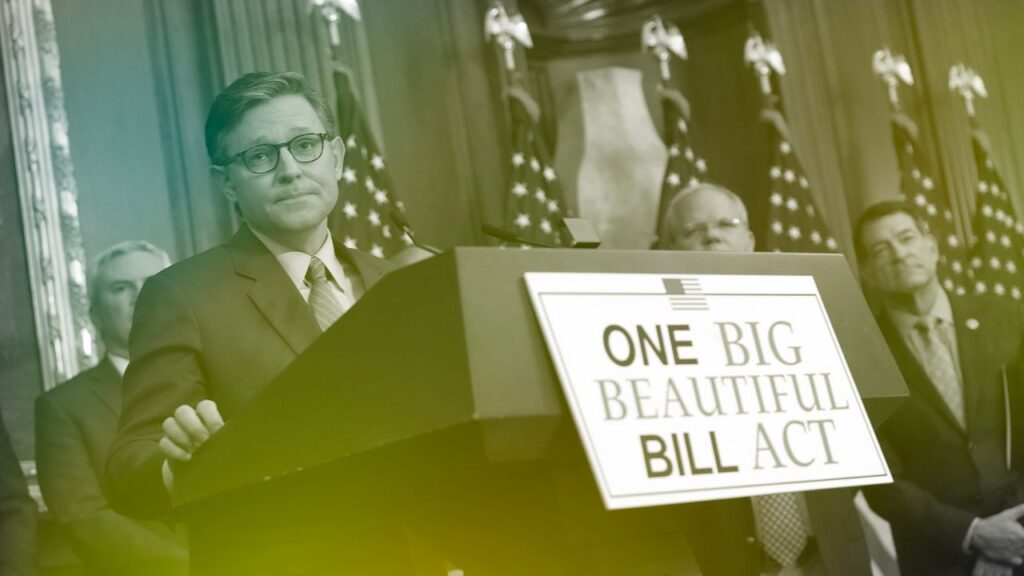As Speaker Mike Johnson and House Republicans were struggling to pass their budget-busting tax-and-spending bill last week—they eventually got it through by a single vote—my mind went back more than three decades to February, 1993, when, in a meeting in the Roosevelt Room of the White House, the newly inaugurated President Bill Clinton met with some of his aides to finalize an economic plan to present to Congress.
The previous November, Clinton had swept to victory on a promise to revive a sluggish economy, the effects of which had been widely blamed on the Republican incumbent, George H. W. Bush. During the campaign, Clinton had talked about raising spending on sectors such as education, infrastructure, and scientific research. In the February meeting, however, Clinton’s top economic advisers, including Bob Rubin, the then head of the National Economic Council, and Lloyd Bentsen, the Treasury Secretary at the time, were advocating substantial cuts in the budget. They argued that this policy would reassure investors about the budget deficit, which the government finances by issuing Treasury bonds, and encourage a rally in bond prices and a decrease in borrowing rates. (When bond prices rise, interest rates fall.) In the 1994 book “The Agenda,” Bob Woodward recounts how some of Clinton’s political operatives felt frustrated by the President’s embrace of fiscal austerity. “How many votes does the fucking bond market have?” Howard Paster, a former lobbyist for the United Auto Workers union, whom Clinton had appointed to liaise with Congress, said at one point in the discussions. “We’ve got to win votes on the Hill, not Wall Street.”
Despite protests from Paster and others, the deficit hawks won out. In August, 1993, Congress passed a tax-and-spending bill that was designed to reduce the deficit by half a trillion dollars over five years. Clinton’s electoral strategist James Carville famously observed, “I used to think that if there was reincarnation, I wanted to come back as the president or the pope or a .400 baseball hitter. But now I want to come back as the bond market. You can intimidate everybody.”
Everybody except Johnson and his colleagues, it seems. On Friday, May 16th, Moody’s Ratings downgraded the credit rating of the U.S. government, a move that left the country without a triple-A rating at a major agency for the first time in more than a century. Throughout the past decade, “federal debt has risen sharply due to continuous fiscal deficits,” Moody’s noted in a statement. “During that time, federal spending has increased while tax cuts have reduced government revenues.” The provisions of the House tax bill, which include extending the Republicans’ 2017 tax cuts and eliminating taxes on tips and overtime, would surely drive the deficit and debt up further. According to the Committee for a Responsible Federal Budget, they would add another $3.1 trillion to the national debt in the next ten years.
After the Moody’s downgrade, bond prices fell, and market interest rates edged up. Last Wednesday, when the Treasury Department held an auction of long-term bonds, investors demanded even higher yields to buy them. Despite these developments, House Republicans, at Donald Trump’s behest, pushed through their One Big Beautiful Bill Act. (Yes, it’s actually called that.) As the voting was taking place on Thursday morning, bond prices dropped lower. Subsequently, they recovered a bit, but the story is far from over.
As attention shifts to the Senate, where Republicans leaders are hoping to pass a bill by July 4th, some Wall Street analysts are predicting that the markets will force a change of course—a scenario for which there is a very recent precedent. At the start of April, Trump’s “Liberation Day” announcement of sky-high tariffs on more than a hundred countries led to a big sell-off in the stock market and a sudden spike in bond yields, which can be a sign of distress somewhere in the financial system. These developments prompted Trump to back down and announce a ninety-day suspension of most of his “reciprocal” tariffs. “The market’s gonna bring discipline to this thing one way or the other,” Tim Magnusson, the chief investment officer at Garda Capital Partners, a hedge fund, told Bloomberg last week. “That’s the only way. It’s always the bond market that brings the discipline.”
Given that some past Presidents, including Barack Obama, managed to shrink the deficit relative to G.D.P. without a crisis in the bond market, that’s a somewhat reductionist take. But right now, with the Republicans controlling both houses of Congress—and with Trump intimidating the vast majority of its members—the markets are clearly reacting negatively to the Administration’s reckless economic policies. Bond rates also affect mortgage rates, which directly impact ordinary Americans. After the Moody’s credit downgrade, when bond yields rose, the cost of home loans ticked higher than seven per cent. Increased mortgage rates aren’t good news for any Administration, and we can safely assume that Trump, as a real-estate developer, keeps a particularly close eye on them. We also know that he watches the bond market. After he did his about-turn on tariffs, the market stabilized and yields somewhat fell, prompting him to remark, “The bond market is very tricky. . . . but if you look at it now it’s beautiful.”
That declaration was premature. The recent rise in bond yields reflects a growing recognition on Wall Street that Trump’s tax-and-spending policies are just as irresponsible as his tariff policies. “What we are learning is that there will be no material fiscal consolidation,” Krishna Guha, an economist at Evercore ISI, told the Wall Street Journal. “The U.S. will continue to run extremely large deficits as far as the eye can see . . . with bigger deficits the next time we experience a downturn or emergency.”
How large is “extremely large”? In 1992, the year before Clinton and his economic team gathered in the Roosevelt Room, the annual deficit was 4.5 per cent of G.D.P., and the total federal debt held by the public amounted to 46.3 per cent of G.D.P. Last year, the equivalent figures were 6.3 per cent and 96.2 per cent. Moody’s, in issuing its downgrade, projected that by 2035, if the House G.O.P. bill were to be enacted, the deficit and debt numbers would have risen to nine per cent and a hundred and thirty-four per cent, respectively.
There is no set formula for when deficits and debts reach crisis levels, but this over-all level of indebtedness would exceed even that seen at the end of the Second World War, when the U.S. government had been, for years, financing the fight against the Axis powers. On the other side of the ledger, many foreign governments and institutional investors still rely on U.S. Treasury bonds as safe and liquid havens for their money. And, as the president of Switzerland’s central bank pointed out after the Moody’s downgrade, “there is currently no alternative to them.”



